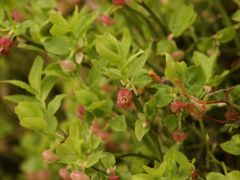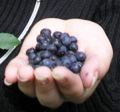Bilberry
| Vaccinium myrtillus subsp. var. | Bilberry, European blueberry, blaeberry, whortleberry, whinberry (or winberry), etc | |||||||||||||||||||||||||||||||||||||||||||||||||||||||
|---|---|---|---|---|---|---|---|---|---|---|---|---|---|---|---|---|---|---|---|---|---|---|---|---|---|---|---|---|---|---|---|---|---|---|---|---|---|---|---|---|---|---|---|---|---|---|---|---|---|---|---|---|---|---|---|---|

|
|
| ||||||||||||||||||||||||||||||||||||||||||||||||||||||
| ||||||||||||||||||||||||||||||||||||||||||||||||||||||||
Bilberry is a name used for several species of Vaccinium (genus) that bear fruit on low-growing shrubs. The species usually referred to as Bilberry is Vaccinium myrtillus, also called the European blueberry. The bilberry has many other names, including blaeberry, whortleberry, whinberry (or winberry), wimberry, myrtle blueberry, fraughan, and black-hearts.
Bilberries can be found growing in damp, acidic soils. North American wild and cultivated blueberries and huckleberries are in the same Vaccinium genus, but the inside of their fruit is light green/white, while the inside of the bilberry is red or purple, often staining the fingers and lips. The bilberry also produced singly or in pairs on the plants, while blueberries come in clusters.
| Standard Cyclopedia of Horticulture |
|---|
|
Vaccinium myrtillus, Linn. Whortleberry. Bilberry. Low glabrous shrub with sharply angled branches: lvs. 1/2 – 2/3 in. long, ovate or oval, serrate, conspicuously reticulate-veined, glabrous, thin and shining: corolla globular ovate; calyx-limb almost entire: berries black, nodding. Mountainous regions, Eu., Asia, possibly N. Amer.—"Generally used as an article of diet and in making of drinks, particularly in the Old World. It is from this species that the common name whortleberry is derived. It is not of much economic importance in Amer." The red-fruited form of the Rocky Mts., and the N. W. has been separated as V. scoparium, Leiberg, and is so recognized by Piper and by Coulter & Nelson. Its occurrence in the trade is doubtful.
|
Other Bilberry species
The name bilberry is the common name sometimes applied to other Vaccinium species, including:
- Vaccinium uliginosum L. (bog bilberry, bog blueberry, bog whortleberry, bog huckleberry, northern bilberry)
- Vaccinium caespitosum Michx. (dwarf bilberry)
- Vaccinium deliciosum Piper (Cascade bilberry)
- Vaccinium membranaceum (mountain bilberry, black mountain huckleberry, black huckleberry, twin-leaved huckleberry)
- Vaccinium ovalifolium (oval-leafed blueberry, oval-leaved bilberry, mountain blueberry, high-bush blueberry).
- More information about this species can be found on the genus page.
Cultivation
Bilberries are rarely cultivated but fruits are sometimes collected from wild plants growing on publicly accessible lands, notably in Fennoscandia, Scotland, Ireland and Poland.
Propagation
- Do you have propagation info on this plant? Edit this section!
Pests and diseases
- Do you have pest and disease info on this plant? Edit this section!
Bilberry is used as a food plant by the larvae of some Lepidoptera species - see list of Lepidoptera which feed on Vaccinium.
Varieties
Gallery
If you have a photo of this plant, please upload it! Plus, there may be other photos available for you to add.
-
Bilberry fruit
-
Bilberry fruit
-
Wild bilberries collected in Norway.
References
External links
- w:Bilberry. Some of the material on this page may be from Wikipedia, under the Creative Commons license.
- Bilberry QR Code (Size 50, 100, 200, 500)


